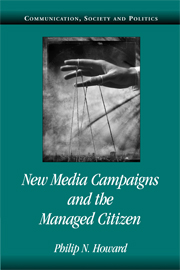Book contents
- Frontmatter
- Contents
- List of Tables and Figures
- Acknowledgments
- Prologue: The Flows of Information in Competitive Politics
- Introduction: The Hypermedia Campaign
- 1 Political Communication and Information Technology
- 2 Producing the Hypermedia Campaign
- 3 Learning Politics from the Hypermedia Campaign
- 4 Organizational Communication in the Hypermedia Campaign
- 5 Managed Citizenship and Information Technology
- Appendix: Method Notes on Studying Information Technology and Political Communication
- Glossary
- References
- Index
- Titles in the series
2 - Producing the Hypermedia Campaign
Published online by Cambridge University Press: 15 December 2009
- Frontmatter
- Contents
- List of Tables and Figures
- Acknowledgments
- Prologue: The Flows of Information in Competitive Politics
- Introduction: The Hypermedia Campaign
- 1 Political Communication and Information Technology
- 2 Producing the Hypermedia Campaign
- 3 Learning Politics from the Hypermedia Campaign
- 4 Organizational Communication in the Hypermedia Campaign
- 5 Managed Citizenship and Information Technology
- Appendix: Method Notes on Studying Information Technology and Political Communication
- Glossary
- References
- Index
- Titles in the series
Summary
By 2050, a piece of software will be a candidate.
– Tracey Westin, DemocracyNet.org (now Grassroots.com)Campaigns are complex exercises in the creation, transmission, and mutation of political symbols. The process of producing these political symbols changed in important ways over the last decade, largely through new tools for producing political campaigns. I illustrate my argument with findings from systematic ethnographies in two organizations devoted to digitizing the social contract. DataBank.com is the pseudonym for a private data-mining company that used to offer its services to wealthier campaigns, but through new media is now able to sell data to the smallest campaigns, nascent grassroots movements, and individuals. Astroturf-Lobby.org is the pseudonym for a political action committee that helps conservative affinity groups seek legislative relief for grievances by helping these groups find and mobilize their sympathetic publics.
There are several reasons to focus particular attention on the role of new media in political communication. Grossman's The Electronic Republic (1996) argues that we are moving into a third stage of democratic evolution. The early direct democracies evolved into representative democracies, and the new electronic media will bring us to a wired reincarnation of direct democracy. “Telecommunications can give every citizen the opportunity to place questions of their own on the public agenda and participate in discussions with experts, policy-makers and fellow citizens” (Grossman 1996, 48). He recognized, however, that it would take a deliberate effort to get technology to work in this way.
- Type
- Chapter
- Information
- New Media Campaigns and the Managed Citizen , pp. 73 - 100Publisher: Cambridge University PressPrint publication year: 2005



